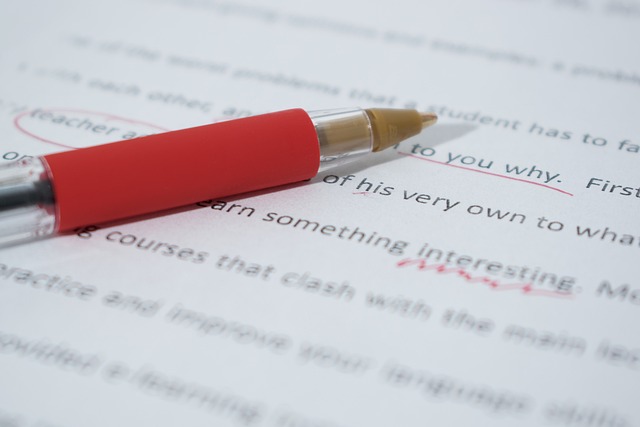Editing involves revising and improving content for clarity, coherence, and style. Proofreading focuses on finding and correcting errors in grammar, spelling, and punctuation.
Understanding Editing
Editing is a comprehensive process that focuses on improving the overall quality, clarity, and effectiveness of a written piece. It involves reviewing and revising the content for various elements, including:
- Content and Structure: Editors assess the overall structure and flow of the text, ensuring that ideas are logically organized and presented in a cohesive manner. They may suggest rearranging paragraphs or sections to enhance readability.
- Clarity and Coherence: Editors work on improving the clarity of the writing by eliminating ambiguities, jargon, or complex language. They ensure that the ideas are expressed in a concise and easily understandable way, enhancing the overall coherence of the piece.
- Tone and Style: Editors consider the intended audience and purpose of the writing, making sure that the tone and style are appropriate. They may suggest changes to achieve a consistent tone throughout or to align the style with the desired voice.
- Grammar and Punctuation: While editing, grammatical errors, punctuation mistakes, and spelling errors are identified and corrected. Editors ensure that sentences are properly structured and adhere to grammatical rules.
- Vocabulary and Word Choice: Editors assess the use of vocabulary and suggest improvements to enhance clarity, precision, and impact. They may suggest alternative words or phrases to convey the intended meaning more effectively.
- Formatting and Presentation: Editors ensure that the formatting, headings, subheadings, and other visual elements are consistent and enhance the readability of the text. They may suggest changes to font styles, spacing, or alignment.
- Citations and References: If the written piece includes references or citations, editors verify that they are properly formatted and follow the required style guide (e.g., APA, MLA).
- Fact-Checking: Editors may verify the accuracy of facts, figures, or information presented in the text. They may suggest additional research or request sources to support claims.
Through the process of editing, the overall quality of the written piece is improved, ensuring that it effectively communicates the intended message to the target audience.
What is Editing?

Editing is the process of revising and correcting written material to improve its clarity, coherence, and overall quality. It involves making changes to sentence structure, grammar, punctuation, and spelling to ensure that the text is error-free and easy to understand. In editing, the primary focus is on improving the flow and organization of the content, as well as enhancing the overall readability. This involves rewording sentences, rearranging paragraphs, and removing any redundant or confusing information. The goal of editing is to make the text more concise, coherent, and engaging for the reader.
Professional editors carefully review the content, paying attention to details such as grammar, punctuation, and spelling errors. They also ensure that the tone and style of the writing are consistent throughout the piece. Editors may provide suggestions for improving the clarity of ideas, strengthening arguments, and enhancing the overall effectiveness of the text. The objective of editing is to produce a polished and error-free piece of writing that effectively communicates the intended message to the reader. A well-edited document is more likely to be understood and appreciated by its target audience.
Different Types of Editing
| Different Types of Editing | Description |
| 1. Structural Editing | Focuses on the overall structure, organization, and coherence of the content. |
| 2. Copy Editing | Involves checking and correcting grammar, spelling, punctuation, and formatting errors. |
| 3. Line Editing | Refines the language, style, and flow of the text, ensuring clarity and readability. |
| 4. Content Editing | Examines the content for accuracy, consistency, and effectiveness in delivering the intended message. |
| 5. Developmental Editing | Concentrates on shaping and refining the content, including plot, characters, and overall narrative structure. |
| 6. Technical Editing | Focuses on editing technical or scientific documents, ensuring accuracy and adherence to specific guidelines or standards. |
When choosing an editing service, it is important to consider the different types of editing required. Structural editing is ideal for improving the overall structure and coherence of your content. Copy editing focuses on correcting grammatical, spelling, and punctuation errors. Line editing enhances the language, style, and flow of the text. Content editing ensures the accuracy, consistency, and effectiveness of the message. Developmental editing is suitable for shaping and refining the content, particularly in fiction writing. Technical editing is specifically tailored for scientific or technical documents.
To make the most informed decision, assess the specific needs of your writing project. Consider the level of detail and expertise required, as well as your budget and timeline. It may be beneficial to discuss your editing requirements with a professional editor to determine which type of editing will best meet your needs.
“The Importance of Editing” lies in its ability to enhance clarity. Editing helps refine and clarify ideas, making them easier for readers to understand. It involves restructuring sentences or paragraphs, removing redundant or ambiguous language, and ensuring the logical flow of ideas.
Additionally, effective editing ensures consistency. By thoroughly editing a piece of writing, you can ensure consistency in tone, style, and formatting. This creates a professional and coherent presentation of the content.
Furthermore, “The Importance of Editing” is evident in its role in strengthening the message. Through editing, you can strengthen the message you want to convey. This includes refining the language and choosing impactful words to engage and persuade the reader effectively.
Of course, one cannot ignore the importance of editing in terms of correcting errors. Editing eliminates grammatical, punctuation, and spelling errors, ensuring that the final product is free from distractions and maintains the credibility of the author.
Moreover, editing allows you to add depth and detail to your writing. It adds depth and detail by incorporating relevant examples, supporting evidence, or clarifying explanations. This makes the writing more engaging and informative.
Exploring Proofreading
Proofreading is the final stage of the editing process and focuses on identifying and correcting errors in grammar, spelling, punctuation, and formatting. It ensures that the written content is accurate, consistent, and polished. Here are key aspects to consider when exploring proofreading:
- Grammar and Spelling: Proofreaders carefully review the text to identify and correct any grammatical or spelling mistakes. This includes checking for subject-verb agreement, verb tense consistency, proper word usage, and correct spelling of words.
- Punctuation and Capitalization: Proofreaders check the text for correct punctuation, including commas, periods, quotation marks, and hyphens. They also ensure proper capitalization of words, including the first word of sentences, proper nouns, and titles.
- Formatting and Style: Proofreaders ensure that the text follows the appropriate formatting and style guidelines. This includes consistent use of font styles and sizes, indentation, spacing, and alignment. They also check for consistency in headings, bullet points, and numbering.
- Consistency and Clarity: Proofreaders review the text for consistency in language, tone, and style. They ensure that the content flows smoothly and is easy to understand for the intended audience. They also check for clarity in sentence structure and eliminate any ambiguous or unclear phrases.
- Typographical Errors: Proofreaders identify and correct typographical errors such as typos, missing or duplicated words, and incorrect spacing. They pay attention to details and meticulously go through each line to ensure the text is error-free.
- Formatting and Layout: Proofreaders check the overall formatting and layout of the document, including headings, subheadings, paragraphs, margins, and page numbers. They ensure that the document looks professional and well-organized.
- Final Review: Proofreaders conduct a final review to ensure that all corrections have been made and the document is ready for publication or submission. They double-check that all errors have been addressed and the content is accurate and error-free.
By carefully examining these aspects, proofreaders play a crucial role in ensuring that written materials are polished, error-free, and ready for public consumption.
What is Proofreading?

Proofreading is the process of carefully examining a written document to identify and correct errors in grammar, punctuation, spelling, and formatting. It is an essential step in the editing process and ensures that the final document is accurate and error-free.
During proofreading, the proofreader focuses on surface-level errors such as misspellings, typos, and grammatical mistakes. They review the text word by word, line by line, and make necessary corrections to improve the clarity and readability of the document. This ensures that the message is conveyed effectively and professionally.
Proofreading is important because it helps maintain the integrity and credibility of the written content. It ensures that the document is free from errors and mistakes that can confuse or mislead readers. By carefully reviewing the document, proofreading helps maintain the professionalism and accuracy of the text.
What is Proofreading? It is crucial to differentiate editing and proofreading. Editing involves more in-depth changes, such as restructuring sentences, clarifying ideas, and improving the overall flow of the text. Proofreading, on the other hand, focuses solely on surface-level errors and does not involve significant revisions to the content itself.
Proofreading is an essential step in the editing process. It involves carefully reviewing a written document to identify and correct errors in grammar, punctuation, spelling, and formatting. By ensuring the accuracy and clarity of the text, proofreading plays a crucial role in creating professional and error-free documents.
The Role of a Proofreader
The role of a proofreader is crucial in the editing and proofreading process. They play a vital part in carefully reviewing a document or text to ensure it is free from errors in grammar, spelling, punctuation, and formatting. Apart from identifying and correcting mistakes, proofreaders also guarantee the consistency and clarity of the content.
Proofreaders possess excellent language skills and have a sharp eye for detail. They meticulously examine every sentence and paragraph to detect any inconsistencies or inaccuracies, ensuring that the intended message of the text effectively reaches the audience.
To effectively fulfill their role, proofreaders must have a thorough understanding of grammar, punctuation rules, and style guidelines. They also need to showcase strong critical thinking skills to identify and address any potential issues with the text.
The ultimate objective of a proofreader is to produce a polished and error-free document that is ready for publishing or distribution. By carefully reviewing and refining the text, proofreaders contribute to enhancing the overall quality and professionalism of the written content.
Distinguishing Between Editing and Proofreading
Objectives of Editing vs Proofreading
The objectives of editing and proofreading serve distinct purposes in the writing process. Editing focuses on improving the overall quality of the content, ensuring clarity, coherence, and structure. It involves reviewing the flow of information, addressing inconsistencies or gaps in logic, and refining the language to enhance readability and engagement.
On the other hand, the objectives of proofreading are to identify and correct errors in grammar, spelling, punctuation, and formatting. Proofreading is the final step in the writing process, ensuring accuracy, polish, and a document free from mistakes that could detract from professionalism or credibility.Both editing and proofreading complement each other and are essential for producing well-crafted and polished written materials. A study conducted by the National Association of Independent Writers and Editors (NAIWE) found that proofreading can improve the accuracy of written materials by up to 95%.
Focus Areas in Editing and Proofreading
- Focus Areas in Editing and Proofreading: One of the key areas of focus in editing and proofreading is to ensure that the grammar and punctuation in the text are correct and consistent. This involves checking for proper sentence structure, correct verb tenses, and proper use of punctuation marks.
- Spelling and vocabulary: Another important aspect of editing and proofreading is to check for spelling errors and ensure that the vocabulary used is appropriate for the target audience. This includes checking for typos, misspelled words, and using the right terminology.
- Clarity and coherence: Editing and proofreading also involves ensuring that the text is clear, coherent, and easy to understand. This includes checking for logical flow of ideas, proper transitions between paragraphs, and eliminating any unnecessary or confusing information.
- Consistency and style: Consistency is crucial in editing and proofreading, ensuring that the text follows a consistent style and tone. This involves checking for consistent formatting, use of headings and subheadings, and adherence to any specific style guidelines.
- Fact-checking and accuracy: Editing and proofreading also includes verifying the accuracy of information presented in the text. This may involve fact-checking, ensuring that any statistics or data cited are accurate and properly sourced.
Editing and Proofreading Techniques
When it comes to refining your writing, mastering the art of editing and proofreading is essential. In this section, we’ll uncover a variety of techniques that can elevate the quality of your work. From exploring different editing techniques that polish your content to diving into the nuances of proofreading that eliminate errors, we’ll provide you with insights and strategies to enhance your writing with precision and finesse. So, let’s take a closer look at these invaluable skills and how they can truly make a difference in your writing journey.
Editing Techniques
When it comes to editing, there are a variety of techniques that can be utilized to ensure the quality and clarity of a written piece. Here are some effective editing techniques to consider:
1. Read aloud: Incorporating the practice of reading your work out loud can assist in identifying any awkward phrasing or grammatical errors that may have been overlooked during silent reading.
2. Check for consistency: It is important to ensure that your writing maintains a consistent tone and style throughout. Additionally, make sure to review the consistency of formatting, including headings, bullet points, and font styles.
3. Remove unnecessary words: Eliminating redundant or repetitive words that do not contribute value to your writing is essential. Maintain conciseness by eliminating any unnecessary filler words or phrases.
4. Correct grammar and punctuation: Be diligent in checking for proper grammar usage, including subject-verb agreement, tenses, and sentence structure. Additionally, review your punctuation, such as commas, periods, and quotation marks, to ensure their correct usage.
5. Improve clarity and organization: Pay attention to the clarity and logical expression of your ideas. Rearrange sentences or paragraphs to enhance the flow and coherence of your writing.
6. Fact-checking: Ensure the accuracy of any factual information presented in your work by conducting thorough fact-checking. Cross-reference your sources and double-check names, dates, statistics, and other details.
7. Proofread for spelling and typos: Methodically scan your document for spelling errors, typos, and inconsistencies. While spell-check tools are helpful, manually reviewing your work is also crucial as certain errors may be missed by spell-check.
Remember, effective editing is crucial for delivering a polished and professional piece of writing. By incorporating these editing techniques, you can help guarantee that your work is error-free and effectively conveys your message.
Proofreading Techniques
When it comes to proofreading techniques, there are several methods that can help ensure accuracy and polish in your written work:
- Read slowly and carefully: Take your time to read each word and sentence thoroughly, checking for any spelling or grammatical errors.
- Read aloud: Reading your text aloud can help you identify any awkward or unclear sentences, as well as detecting any missing words or punctuation.
- Use a spellchecker: Utilize the spellcheck feature in your writing software to catch any obvious spelling mistakes.
- Print it out: Proofreading a printed copy of your text can make it easier to spot errors that may have been overlooked on screen.
- Focus on one issue at a time: Instead of trying to catch every error in one go, focus on specific elements such as punctuation, grammar, or spelling, ensuring each is correct before moving on.
Pro-tip: After applying proofreading techniques to your work, it’s always a good idea to have a second set of eyes review it as well. Another person may notice errors or offer suggestions that you may have missed.
When to Use Editing vs Proofreading
Knowing when to use editing versus proofreading can help you ensure the quality and accuracy of your written work. Here are the key considerations:
- Editing: Editing focuses on improving the overall quality, clarity, and effectiveness of the written content. It involves reviewing and revising the content for structure, organization, tone, style, and coherence. Editors may make substantial changes to the text, such as rewriting sentences or paragraphs, reordering information, or suggesting additional content. Editing is typically done before proofreading and is essential for refining the content and ensuring it meets the intended purpose and audience expectations.
- Proofreading: Proofreading is the final stage of the writing process and focuses on identifying and correcting errors in grammar, spelling, punctuation, and formatting. Proofreaders carefully examine the text for typos, inconsistencies, and small errors that may have been missed during the editing phase. Proofreading is important for ensuring accuracy, professionalism, and adherence to established language conventions. It is typically done after editing and is the last step before finalizing and publishing the written work.
Frequently Asked Questions
What’s the Difference Between Editing and Proofreading?
Editing and proofreading are two distinct services that writers can utilize to enhance the quality of their writing. While editing focuses on improving the overall quality by suggesting changes to language use and expression, proofreading concentrates on correcting surface errors such as grammar, spelling, and punctuation. Think of editing as enhancing the clarity and consistency of the writing, while proofreading ensures that the text is error-free.
Why is proofreading important for any writing intended for publication?
Proofreading plays a vital role in ensuring the clarity and accuracy of writing intended for publication. Spelling, grammar, and punctuation errors, as well as inconsistency in language, can undermine the impact of the writing. It helps to communicate the message clearly and effectively and ensures that there are no mistakes that can distract or confuse the readers.
Can’t I just use a computer program or ask a friend to proofread my work?
While you can certainly use computer programs or seek the help of a friend to proofread your work, it’s worth noting that a professional editor possesses specialized skills in identifying and eliminating errors, inconsistencies, and formatting issues. They have a deep understanding of English writing conventions and can catch mistakes that others might overlook. Therefore, opting for a professional editor ensures a higher level of accuracy and clarity in your writing.
What does editing involve besides correcting surface errors?
Editing goes beyond simply correcting surface errors like grammar and punctuation. It focuses on enhancing the flow, readability, and structure of the writing. Editors consider factors such as word choice, tone, sentence length, and essay structure. They may make extensive changes to the text to convey the meaning and ideas in the best possible way for the audience. Editing also involves clarifying the text using specialized knowledge of the subject matter and fact-checking.
How should I approach the editing and proofreading process for my own work?
It is recommended to edit first and proofread last as a final step before submitting your work. When editing your own work, take a break of a day or two to gain a fresh perspective or seek feedback from others. Additionally, it can be valuable to get help from a second set of eyes, such as using online essay feedback services like Studiosity’s Writing Feedback. This allows you to benefit from the expertise of writing specialists who can offer valuable suggestions and insights.
Why is proofreading essential before marking an assignment?
Proofreading an assignment before marking is essential to ensure that it is error-free. Proofreading helps identify and correct surface errors such as grammar, spelling, and punctuation, as well as inconsistencies in terminology, formatting, and referencing. It ensures that the assignment meets the required standards of language use and accuracy. Proofreading also helps to identify any consistent mistakes that can be avoided in the future, allowing for continuous improvement in writing skills.
Image Credits
Featured Image By – upklyak on Freepik
Image 1 By – Freepik
Image 2 By – Lorenzo Cafaro from Pixabay








